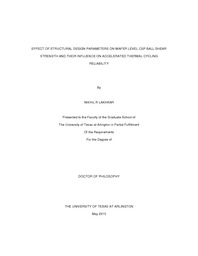
ATTENTION: The works hosted here are being migrated to a new repository that will consolidate resources, improve discoverability, and better show UTA's research impact on the global community. We will update authors as the migration progresses. Please see MavMatrix for more information.
Show simple item record
| dc.contributor.author | Lakhkar, Nikhil R. | en_US |
| dc.date.accessioned | 2010-07-19T19:54:40Z | |
| dc.date.available | 2010-07-19T19:54:40Z | |
| dc.date.issued | 2010-07-19 | |
| dc.date.submitted | January 2010 | en_US |
| dc.identifier.other | DISS-10613 | en_US |
| dc.identifier.uri | http://hdl.handle.net/10106/4893 | |
| dc.description.abstract | Wafer level chip scale package (WLCSP) is one of the most popular packages due to its size and cost advantages. It is expected that the usage of WLCSP in microelectronics and MEMS industry combined is going to cross 16000 Million Units by 2013. One of the main advantages of implementing WLCSP is its time to market because most of the package is done at the wafer level. Once the wafer processing is completed the package is just diced and mounted on board and the board is ready to go. However, just like any other package WLCSP too is not ideal and do have weaknesses from reliability point of view. The advantage of having a WLCSP is that the reliability program can be divided into two parts namely Wafer level reliability and Board level reliability. Ball shear test, Ball pull test etc. are some of the popular wafer level reliability tests that are very commonly employed in wafer fabs. Popular Board level accelerated tests are Drop tests and accelerated thermal cycling. Typically, the time taken by the board level reliability tests is much more as compared to wafer level reliability tests. Various researchers have attempted to correlate board level and wafer level reliabilities using experimental and statistical correlations. Such correlations exist for High speed shear and high speed ball pull and board level drop testing. However, such correlations don't exist for accelerated thermal cycling and wafer level reliability tests. In this dissertation, three different solder compositions, three solder sizes are mounted on two structures that are very commonly used in wafer level chip scale packages. The structures are fabricated on wafer and sheared off using a commercially available ball shear tester and two important results were noted (a) ball shear strength and (b) % ductile failure mode incidence. The structures were sheared off at two different heights namely 25μm and 125μm heights. The results in terms of gram force from both heights were combined in a statistical term called as Signal to Noise ratio which is Negative logarithm to the base 10. Results obtained using experimental ball shear were validated computationally using commercially available finite element codes. Similar WLCSP packages were assembled on standard accelerated thermal cycling boards and were cycled between temperature extremes of -40ºC and 125ºC at the frequency of 2 cycles/hr.Weibull plots were obtained for all board assemblies for different scenarios considered in the study. Results from accelerated thermal cycling and ball shear testing were matched using two ways (a) the stress and inelastic strain from both the tests were matched on a log-log plot and (b) % ductile failure mode from ball shear testing was matched with Number of cycles and Weibull parameter from accelerated thermal cycling using CORREL function and correlation coefficients were determined. The correlation coefficients were determined from taking into consideration the variation in structure and corresponding changes in the Number of cycles in accelerated thermal cycling. Effect of individual structural parameters on the fatigue life was analyzed and corresponding recommendations were made. It was concluded that matching stress- strain from accelerated thermal cycling and ball shear strength didn't result into any correlations. % ductile failure mode is a better parameter in establishing correlations between the two tests. | en_US |
| dc.description.sponsorship | Agonafer, Dereje | en_US |
| dc.language.iso | EN | en_US |
| dc.publisher | Mechanical Engineering | en_US |
| dc.title | Effect Of Structural Design Parameters On Wafer Level CSP Ball Shear Strength And Their Influence On Accelerated Thermal Cycling Reliability | en_US |
| dc.type | Ph.D. | en_US |
| dc.contributor.committeeChair | Agonafer, Dereje | en_US |
| dc.degree.department | Mechanical Engineering | en_US |
| dc.degree.discipline | Mechanical Engineering | en_US |
| dc.degree.grantor | University of Texas at Arlington | en_US |
| dc.degree.level | doctoral | en_US |
| dc.degree.name | Ph.D. | en_US |
| dc.identifier.externalLink | https://www.uta.edu/ra/real/editprofile.php?onlyview=1&pid=4 | |
| dc.identifier.externalLinkDescription | Link to Research Profiles | |
Files in this item
- Name:
- Lakhkar_uta_2502D_10613.pdf
- Size:
- 12.66Mb
- Format:
- PDF
This item appears in the following Collection(s)
Show simple item record


